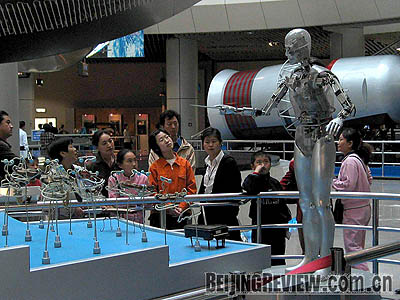|

HEAVY METAL: Visitors watch a musical performance staged by robots at the China Science and Technology Museum
Advanced technology developed for the Olympic Games was showcased at the China Science and Technology Museum in Beijing from May 17 to 23, the National Science and Technology Week.
Visitors to the museum could touch the Olympic torch, which is capable of staying alight in oxygen-thin air atop Mount Qomolangma (Everest). The torch was designed with technology used in rocket combustion systems.
A digital swim training device used by Olympic gold medalists was also displayed in the museum. The device can imitate a swimmers' movements, tracking such technical performance parameters as the power of muscle groups and eruption force.
Other hi-tech Olympic items on show included a badminton racket made of carbon fibre, plastics and titanium alloy. The racket weighs no more than 200 grams. The racket that Chinese tennis player Li Na will use during the Beijing Olympic Games was also exhibited.
On International Children's Day this year, the museum hosted hands-on science activities to give children first-hand experience of science and technology. Children designed, carved and put together an agile wooden mechanical animal that could climb along a rope. They also directed robots to play an Olympic football contest.
China Science and Technology Museum was the first comprehensive national scientific museum in China. It is located at the northwest corner of Anhua Bridge on the northern section of the 3rd Ring Road, Beijing. The first phase of the museum was completed and opened to the public in September 1988 and the second phase was opened in April 2000. The museum comprises three exhibition halls. Exhibition Hall A is the primary exhibition hall, Exhibition Hall B is an astro-vision theater and Exhibition Hall C is a science garden for children.
The museum features numerous scientific "miracles" that contradict common sense. One is a cone holding water that climbs up, rather than flowing down. Another strange phenomenon is that steel balls can rise to the surface of water while wooden balls sink to the bottom. An unusual seesaw in the museum allows one person to lift four. The exhibitions are intended to help people understand complicated science while being entertained at the same time.
"Science is exciting. The items on display and the activities hosted by the museum crystallize the fruits of human exploration and innovation," said Xu Yanhao, Curator of the museum. "By giving visitors first-hand experience in science and technology, the museum will enrich their knowledge and attract more people into science."
The astro-vision theater in the museum is one of the largest in the world. It has a dome of 27 meters in diameter, a screen of about 1,000 square meters and houses 470 seats. The top quality visual and audio effects produced by the state-of-the-art equipment give visitors an illusion that they are experiencing the real thing.
"A shark suddenly emerged from the blue sea water. It dashed toward me and then turned around. Wow, its tail almost brushed my face," wrote one boy after a visit to the astro-vision theater. "During my adventure there, I saw the colorful vibrant world beneath the serene sea surface. We should protect the beautiful world."
A new exhibition hall is being added to the museum. The design of the new hall was available one year ago for public comments. Located inside the Olympic National Park, the new hall occupies a land area of 480,000 square meters and has a floor area of 31,000 square meters dedicated to exhibitions. More than 1.1 billion yuan ($157 million) has been invested in the project. Part of the hall will be open to the public this August during the Beijing Olympic Games. The entire hall will be officially opened later next year. |